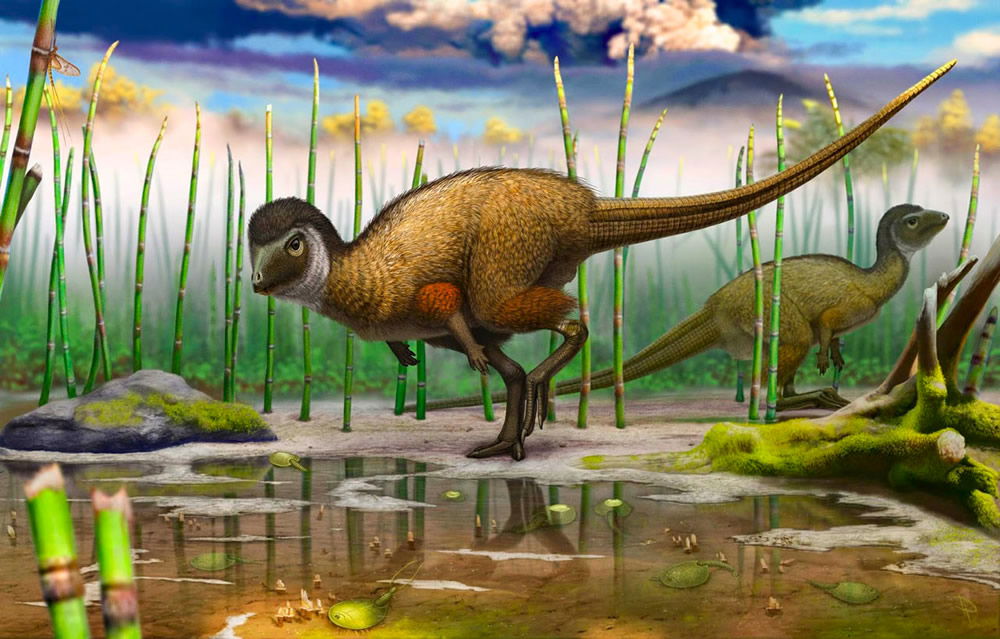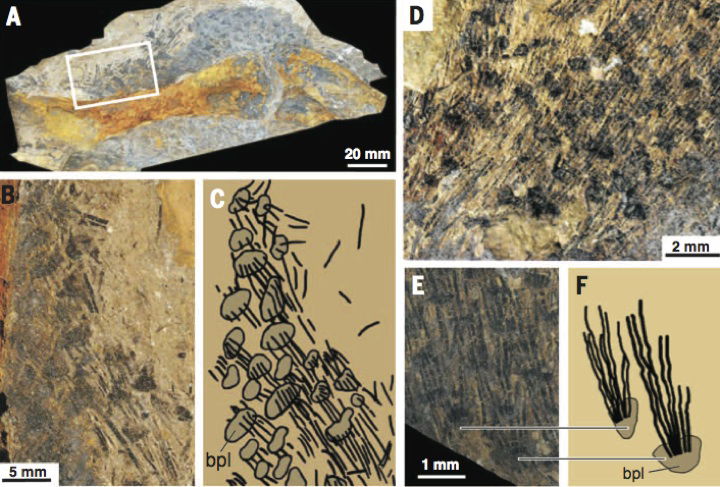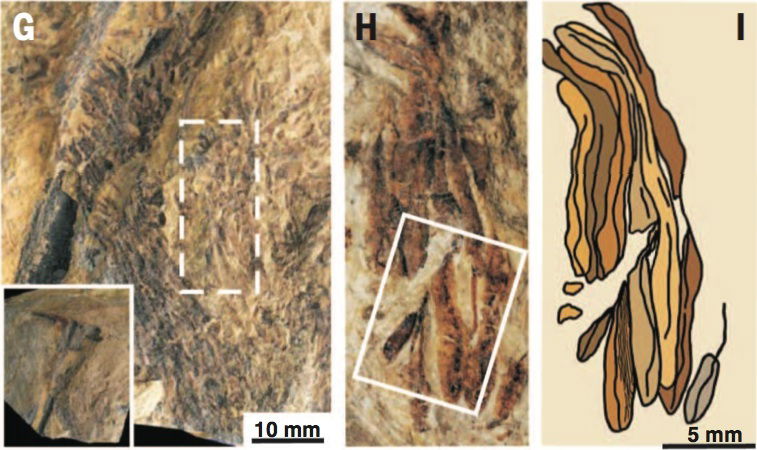
Did All Dinosaurs Have Feathers?
News to Know
Abstract
Get used to seeing feathers on all evolutionary depictions of dinosaurs, not just theropods!
News Sources
- Sci-News: “Kulindadromeus zabaikalicus: Feathered Herbivorous Dinosaur Discovered”
- National Geographic: Siberian Discovery Suggests Almost All Dinosaurs Were Feathered
A Jurassic jumble of bones in Siberia has yielded a newly identified dinosaur species, Kulindadromeus zabaikalicus. Named for the Kulinda River near two dinosaur graveyards, Kulindadromeus (pronounced coo-LIN-dah-DROE-mee-us) may, its discoverers hope, be the first herbivorous dinosaur with “confirmed” feathers.1 The new species—with exquisitely preserved scales and bristles but no feathers—was found in southeastern Siberia’s Ukureyskaya Formation, which evolutionists believe to be 144 to 169 million years old. If the evolutionary community chooses to view the filaments on these fossils as feathers, evolutionary artists may start sketching all dinosaurs with feathers!
Explaining how this dinosaur’s bristles—and their proposed interpretation—may affect future perception of all dinosaurs, University of Edinburgh evolutionary paleontologist Stephen Brusatte2 says:
The new Siberian fossils are the best example yet that some ornithischian dinosaurs had feathers, so it wasn’t only the theropods that had downy coats. This does mean that we can now be very confident that feathers weren’t just an invention of birds and their closest relatives, but evolved much deeper in dinosaur history. I think that the common ancestor of dinosaurs probably had feathers, and that all dinosaurs had some type of feather, just like all mammals have some type of hair.3
Meet Kulindadromeus
Six skulls and hundreds of disarticulated skeletons reveal that Kulindadromeus was about five feet long including its tail. It likely stood upright on its hind legs, as its front legs were very short. There is no indication that it could fly. It had a short, beaky-looking face like other “ornithischian” dinosaurs as well as teeth typically associated with herbivores. It had several types of scales and bristles, each associated with particular regions of the body.

This is an artist’s depiction of Kulindadromeus, a species of ornithischian dinosaur discovered in a Siberian dinosaur graveyard. Its well-preserved skin reveals detailed impressions of scales and bristles of various types, but no feathers, despite claims by evolutionary paleontologists. Image by Andrey Atuchin, via Sci-News.
Scales and Bristles
Kulindadromeus fossils display an assortment of scales and bristles, all remarkably preserved in fine detail. There are large thin scales on its tail, medium-sized scales on the lower legs, and tiny scales over its hands and feet. There are also thin bristles of various sorts on the head and body and little groups of bristles each attached to a scale-like base on the arms and thighs.
The scales include hexagonal scales (<3.5 mm long) overlapping like roof tiles covering the lower tibia (shin bone), reported as “resembling the scutella in modern birds.”5 Tiny round non-overlapping scales (<1 mm) appear along the ankle, foot, wrist, and hand bones. Larger scales up to 20 mm long and 10 mm wide protected this dinosaur’s tail. Very thin (<100 µm) and slightly overlapping, they are arranged in five longitudinal rows, with the largest ones near the body.
The bristles include monofilaments scattered on the body and head, with the thinnest and shortest (0.15 mm diameter, 10–15 mm long) on the head and slightly larger bristles (0.2–0.3 mm diameter, 20–30 mm long) elsewhere. According to the researchers, these bristles resemble the monofilament “dino-fuzz”4 on the theropod Sinosauropteryx.5 Though National Geographic describes these randomly oriented bristles as “streamlining”6 the body, Godefroit’s team reports they have “no preferred orientation.”5
Located on the upper arms and thighs are tufts of fine, inch-long filaments. Each tuft consists of six or seven filaments connected to a little plate at the base. The little plates, which may be “modified scales,”5 are arranged in hexagonal patterns but are not contiguous with each other. There are no shafts, barbs, or barbules on these patterned tufts of bristles, but the authors liken them to the barbule-lacking down on some modern varieties of chickens,5 but down normally has some barbules and certainly has no basal plates like these. Near the knees are “ribbon-shaped elements . . . an arrangement that has never previously been reported and that could represent a third feather-like morphotype in Kulindadromeus,”5 the researchers suggest, but both the size and resolution of the images (Fig. G, H, and I) give no clear evidence for classifying these structures as feathers, such as barbs and barbules.
Kulindadromeus has bristles, not feathers. Nevertheless, coauthor Maria McNamara says, “These feathers are really very well preserved.”6 The researchers conclude “grouped filaments that we interpret as avianlike feathers”5 suggest “that all Dinosauria could have had feathers and that feathers arose for purposes of insulation and signaling and were only later co-opted for flight.”5

 These scales around the lower leg (A) and tail (B and C) were preserved in remarkable detail on fossilized dinosaurs in Siberian Jurassic dinosaur graveyards. Such detail demands that these animals were quickly and catastrophically buried without time to decay. Image: P. Godefroit et al., “A Jurassic ornithischian dinosaur from Siberia with both feathers and scales,” Science 345 (25 July 2014): 451–455.
These scales around the lower leg (A) and tail (B and C) were preserved in remarkable detail on fossilized dinosaurs in Siberian Jurassic dinosaur graveyards. Such detail demands that these animals were quickly and catastrophically buried without time to decay. Image: P. Godefroit et al., “A Jurassic ornithischian dinosaur from Siberia with both feathers and scales,” Science 345 (25 July 2014): 451–455.
 These filaments on the forelimb (in A, B, and C) and hindlimb (in D, E, and F) of Kulindadromeus fossils represent the most complex of the filaments on the fossils. These bristles are connected at the base to small plates arranged in a hexagonal pattern. There are no shafts, barbs, or barbules as would be expected if these were actually feathers. The basal plates may be a kind of scale, the researchers suggest. Image: P. Godefroit et al., “A Jurassic ornithischian dinosaur from Siberia with both feathers and scales,” Science 345 (25 July 2014): 451–455.
These filaments on the forelimb (in A, B, and C) and hindlimb (in D, E, and F) of Kulindadromeus fossils represent the most complex of the filaments on the fossils. These bristles are connected at the base to small plates arranged in a hexagonal pattern. There are no shafts, barbs, or barbules as would be expected if these were actually feathers. The basal plates may be a kind of scale, the researchers suggest. Image: P. Godefroit et al., “A Jurassic ornithischian dinosaur from Siberia with both feathers and scales,” Science 345 (25 July 2014): 451–455.
 Godefroit’s team of paleontologists also noticed, higher up on the tibia from the other bristles, some “clusters of six or seven ribbon-shaped elements. . . . Each individual element is 15 to 20 mm long and 1.5 to 3 mm wide.”5 They admit that they do not know what these are, as “This is an arrangement that has never previously been reported.”5 Due to their bias that the bristles on this animal are feathers, or at least elements in the evolutionary history of feathers, they conclude that the ribbons “could represent a third featherlike morphotype in Kulindadromeus.”5 The size and lack of resolution of these fossilized ribbon structures are certainly not very convincing—and there is no mention of barbules or hooks on these structures in the literature; therefore it must be their feathery bias that prompts them to see these unique, unidentified, ribbon-shaped elements as feathers. Image: P. Godefroit et al., “A Jurassic ornithischian dinosaur from Siberia with both feathers and scales,” Science 345 (25 July 2014): 451–455.
Godefroit’s team of paleontologists also noticed, higher up on the tibia from the other bristles, some “clusters of six or seven ribbon-shaped elements. . . . Each individual element is 15 to 20 mm long and 1.5 to 3 mm wide.”5 They admit that they do not know what these are, as “This is an arrangement that has never previously been reported.”5 Due to their bias that the bristles on this animal are feathers, or at least elements in the evolutionary history of feathers, they conclude that the ribbons “could represent a third featherlike morphotype in Kulindadromeus.”5 The size and lack of resolution of these fossilized ribbon structures are certainly not very convincing—and there is no mention of barbules or hooks on these structures in the literature; therefore it must be their feathery bias that prompts them to see these unique, unidentified, ribbon-shaped elements as feathers. Image: P. Godefroit et al., “A Jurassic ornithischian dinosaur from Siberia with both feathers and scales,” Science 345 (25 July 2014): 451–455.
Tweaking the Tale of Feathered Dinosaurs
Dinosaurs are either ornithischians ( “bird-hipped”) or saurischians ( “lizard-hipped”), based on the way their pelvic bones are shaped, and evolutionists consider them divergent lineages. Kulindadromeus is an ornithischian, not in the saurischian lineage to which evolutionists traditionally assign feathers. Therefore, Godefroit says, “The way we think of dinosaurs may have to change.”7
Placing Kulindadromeus near the bottom of the evolutionary tree, shortly after the presumed divergence of ornithischians and saurischians, Godefroit suggests feathers evolved very early—220 million years ago in the Triassic period. “Probably that means the common ancestor of all dinosaurs had feathers,” Godefroit explains. “Feathers are not a characteristic [just] of birds but of all dinosaurs.”3
“I was really amazed when I saw this,” he says. “We knew that some of the plant-eating ornithischian dinosaurs had simple bristles,8 and we couldn’t be sure whether these were the same kinds of structures as bird and theropod feathers. Our new find clinches it: all dinosaurs had feathers, or at least the potential to sprout feathers.”6
Feathers Plus Scales?
If the evolutionary community accepts Godefroit’s assessment that these filaments/ribbons are really feathers, instead of trying to figure out how something as complex and irreducibly complex as feathers could evolve from scales, coexistence of scales with feathers would demand a new feather evolution story.9 They might turn the tables and say scales evolved from feathers. Coauthor Danielle Dhouailly invokes a specious embryonic recapitulation argument for support:
Developmental experiments in modern chickens suggest that avian scales are aborted feathers, an idea that explains why birds have scaly legs. The astonishing discovery is that the molecular mechanisms needed for this switch might have been so clearly related to the appearance of the first feathers in the earliest dinosaurs.6
The developmental sequences and molecular mechanisms within the embryonic development of a particular species under the direction of that animal’s genetic blueprint are observable. However, it is not reasonable to extrapolate them as proof of hypothetical evolutionary transitions to more complex species.
Origin of Feathers?
Each kind of feather is fully functional, and the feathers in the fossil record do not transition from scales or from one type to another.
Feathers are clearly present in the fossil record as deep as the Cretaceous. However, the fossil record does not demonstrate an evolutionary pathway leading to feathers. Each kind of feather is fully functional, and the feathers in the fossil record do not transition from scales or from one type to another. While feathers serve many purposes—courtship displays, insulation, waterproofing, streamlining, and so forth—the existence of non-flight functions is not evidence that feathers evolved for simpler purposes and then got recruited to get “early birds” off the ground. So many other structures are unique and necessary to the needs of birds for flight—or even for maintenance of feathers. Nothing about these dinosaur bristles reveals anything about feathers. The exquisite state in which these bristles and scales are preserved illustrates something far more important: the fact that God’s Word is true.
Did Kulindadromeus Have a Very Bad Day?
The Siberian Jurassic bonebeds where Kulindadromeus was found contain lots of “well-preserved fossils of plants, insect larvae, and freshwater crustaceans that suggest deposition in a low-energy, probably lacustrine [lake], freshwater environment,”5 the paleontologists write. In one of the bonebeds “some of the bones . . . are articulated and delicate integumentary structures are preserved as a thin layer of carbon,”10 they write, concluding “It is clear that this horizon was deposited in a very calm environment.”10 Godefroit paints this word picture to explain the past:
There were lakes and there were volcanoes there, lots of volcanoes. The plant-eating dinosaurs likely died and fell to the lake bottom, where eruptions soon after covered them with a fine ash. That is what preserved the feather imprints with the fossil bones. We don't know how big this fossil bed is, and it is likely we will find more when we go back.3
Answers in Genesis geologist Dr. Andrew Snelling, studying the descriptions of fossil sites described by the paleontologists in their paper and supplementary materials, notes that they are “indicative of a lot of highly explosive rhyolitic volcanism” and observes that millions of years are not needed to produce the formations the paleontologists describe:
Yet how is highly explosive rhyolitic volcanism conducive to a “low-energy” environment proposed by Godefroit? Thick laminated tuffaceous/pyroclastic sediments, like those described by the paleontologists, have been witnessed to form within hours, with alternating fine and coarser laminations, as a result of deposition from an explosive eruption at Mt. St. Helens on June 12, 1980, which produced ash-fall and pyroclastic flows moving at hurricane velocity.
However, since burial under such hot volcanic ash would incinerate and destroy both plants and dinosaur bones, the volcanic ash had to have been water-transported from where it was erupted nearby. Furthermore, for plants and insect larvae to be well preserved still requires virtually instantaneous, rapid burial under a lot of sediments.
Indeed, the fact that six partial skulls and several hundred disarticulated skeletons were unearthed from two neighboring bone beds which contained only dinosaur bones from the one species indicates a destructive event was responsible for ripping the carcasses of these creatures apart and separating their bones from other critters to be only buried with plants, crustaceans and insect larvae.
Both plants and insect larvae are quite delicate structurally, yet debris flows would seem to be the best candidate for their rapid transport and burial with this assortment of disarticulated dinosaur bones. The subsequent deformation of laminae also indicates anything but a calm environment.
There is an answer, Dr. Snelling points out, that puts all the observable facts together—hundreds of disarticulated skeletons and some more intact ones, volcanic material, and preservation of delicate flora and fauna and anatomical details—in a way consistent with the history of the global Flood recorded in the Bible:
Putting the pieces of this puzzle together, rapid recent burial in a combined volcanic and watery catastrophe is consistent with the biblical eyewitness description of the Genesis Flood. It would otherwise seem very unlikely under slow-and-gradual lake environment conditions for such bone beds to have the disarticulated parts of just one species of dinosaur buried en masse with such well-preserved details, along with delicate insect larvae.
But during the Flood such dinosaurs would have been corralled by the rising waters and then swept away, to eventually be caught in swift debris flows consisting of volcanic ash and other fine sediments. Entombed rapidly as the sediments settled swiftly, this whole process had to be recent for these intricately detailed fossils, some preserved only as carbon films, to not succumb to weathering and decay. But then the Genesis Flood cataclysm occurred only about 4,350 years ago!
Like the hadrosaurs whose tracks we discussed a few days ago, these dinosaurs had a very bad day when the global Flood overtook their corner of the pre-Flood world. Rather than suggesting that all dinosaurs had feathers, the fossils showcase a sort of bristly scaly dinosaur skin designed by God and now sadly lost to extinction. Their preservation affirms God’s judgment and power manifested in the global Flood, which is faithfully reported (Genesis 6–9) in the Bible.
Further Reading
- What Color Were Dinosaurs?
- Did Dinosaurs Turn into Birds?
- The Evolution of Feathers: A Major Problem for Darwinism
- Classic Black
- Persistent Protein
- Paleo-sorting Morphs Three Dinosaurs into One
- Feathered Fossil: Still a Bird
- Feathered Dinosaurs Found in Canada?
- Trueorigin.org: On The Alleged Dinosaurian Ancestry Of Birds
For More Information: Get Answers
Remember, if you see a news story that might merit some attention, let us know about it! (Note: if the story originates from the Associated Press, FOX News, MSNBC, the New York Times, or another major national media outlet, we will most likely have already heard about it.) And thanks to all of our readers who have submitted great news tips to us. If you didn’t catch all the latest News to Know, why not take a look to see what you’ve missed?
(Please note that links will take you directly to the source. Answers in Genesis is not responsible for content on the websites to which we refer. For more information, please see our Privacy Policy.)
Footnotes
- In the paper published in Science (Pascal Godefroit et al., “A Jurassic Ornithischian Dinosaur from Siberia with Both Feathers an Scales,” Science 345, no. 6195 (July 25, 2014): 451–455, doi:10.1126/science.1253351), the authors are cautious about calling the filaments on these fossils “feathers”—instead referring to them as “featherlike” (page 453) and noting that they interpret filaments as “avianlike feathers” (page 452). However, their title— “A Jurassic ornithischian dinosaur from Siberia with both feathers and scales”—as well as statements by the authors and others quoted in the media and journalists discussing the discovery repeatedly call these non-feather filaments “feathers.” Thus both evolutionary paleontologists and journalists are guilty of misrepresenting or at least conflating observations with interpretative worldview-based opinions.
- Not involved with the study.
- Dan Vergano, “Siberian Discovery Suggests Almost All Dinosaurs Were Feathered,” National Geographic, July 24, 2014, http://news.nationalgeographic.com/news/2014/07/140724-feathered-siberia-dinosaur-scales-science/.
- Some evolutionists believe the bristle like monofilaments called “feathers” by some are just collagen fibrils. See Theagarten Lingham-Soliar, Alan Feduccia, Xiaolin Wang, “A New Chinese Specimen Indicates that ‘Protofeathers’ in the Early Cretaceous Theropod Dinosaur Sinosauropteryx Are Degraded Collagen Fibres,” Proc R Soc B 274 (August 7, 2007): 1823–1829, doi:10.1098/rspb.2007.0352. See also “Birdy-O-Saur Under Dispute,” Answers in Genesis, May 26, 2007, https://answersingenesis.org/dinosaurs/feathers/birdy-o-saur-under-dispute/.
- Godefroit et al., “A Jurassic Ornithischian Dinosaur from Siberia with Both Feathers and Scales.”
- “Kulindadromeus zabaikalicus: Feathered Herbivorous Dinosaur Discovered,” Sci-News, July 25, 2014, http://www.sci-news.com/paleontology/science-kulindadromeus-zabaikalicus-feathered-herbivorous-dinosaur-02079.html.
- Russell Brandon, “A New Fossil Suggests ‘All Dinosaurs’ May Have Had Feathers,” The Verge, July 24, 2014, http://www.theverge.com/2014/7/24/5933949/a-new-fossil-suggests-dinosaurs-may-have-had-feathers.
-
A couple of other ornithischians from China also have some sort of bristles that differ from those on Kulindadromeus. Godefroit’s team writes in their study in Science about the implications of identifying all these ornithischian filaments as feathers:
But were feathers more widespread among dinosaurs? Quill-like structures have been reported in the ornithischians Psittacosaurus and Tianyulong, but whether these were true feathers, or some other epidermal appendage, is unclear. Bristlelike epidermal appendages occur in pterosaurs, some early theropods, and extant mammals (“hairs”), and so the Psittacosaurus and Tianyulong filaments might have evolved independently of the feathers of theropods (from P. Godefroit et al., “A Jurassic ornithischian dinosaur from Siberia with both feathers and scales,” Science 345 (25 July 2014): 451–455).
- Of course modern birds have both feathers and scales, but the question for evolutionists is where feathers and scales came from in the distant past. Evolutionary scenarios to explain the origin of feathers typically invoke the transformation of scales into something far more complex.
- Godefroit et al., “A Jurassic Ornithischian Dinosaur from Siberia with Both Feathers and Scales.”
Recommended Resources

Answers in Genesis is an apologetics ministry, dedicated to helping Christians defend their faith and proclaim the good news of Jesus Christ.
- Customer Service 800.778.3390
- © 2024 Answers in Genesis





